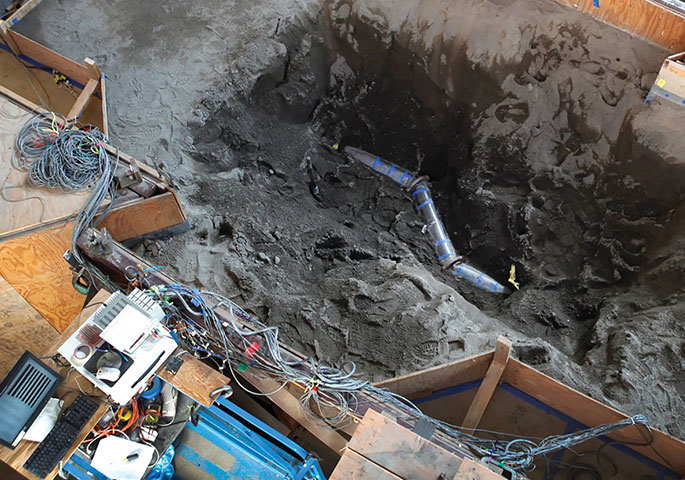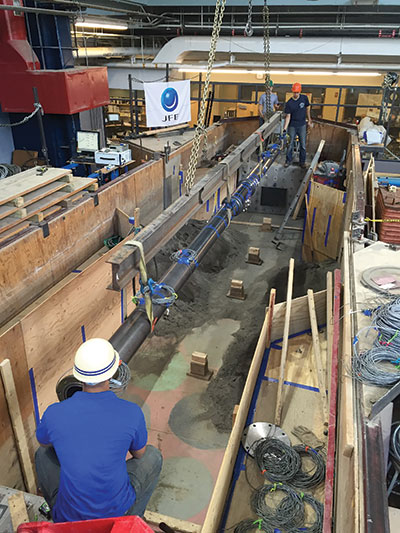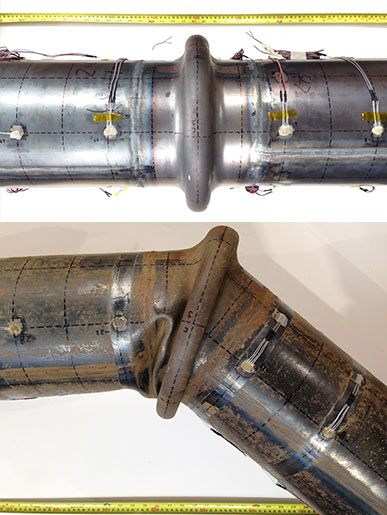October 2016 Vol. 71 No. 10
Features
Promising Earthquake Resistant Steel Pipe For Water, Oil, Gas

Devastation caused by major earthquakes is well-known – dramatic video clips vividly document the destruction of collapsed buildings, caved-in highways, fallen bridges and debris scattered across the landscape.
However, not all damage is visible.
Violent shifts underground can rupture water, sewer and energy pipelines, not only cutting off essential services but posing serious health risks. Ruptured natural gas lines can cause explosions, followed by fires.
In Ithaca, NY, Cornell University recently completed a series of tests on a new, earthquake-resistant pipe that ultimately could provide a significant measure of protection to buried infrastructure.

The steel pipe, developed in Japan by JFE Holdings, has what is described as a unique “wave” design to control buckling, allowing the pipe to bend and compress without rupturing or losing water pressure.
While the pipe tested is for water distribution systems, the technology could be applicable to steel pipelines carrying other resources such as oil and gas.
Pipe tests at the Cornell Geotechnical Lifelines Large-Scale Testing Facility mimicked a fault rupture that can occur during an earthquake when global plates begin to slip past each other, causing the ground to shift and deform, said Brad Wham, postdoctoral associate at Cornell’s School of Civil and Environmental Engineering. Wham designed and supervised the testing.
A 28-foot-long section of 8-inch diameter pipe was fitted with more than 120 monitoring instruments and buried within 80 tons of soil, Wham said. The experiment took more than a month for the research team to prepare.
“A large, hydraulically powered ‘split box’ imposed two feet of fault rupture along a 50-degree angle, forcing the buried pipeline into a combination of compression and bending,” Wham explained. “The pipe was able to accommodate the two feet of movement and didn’t spring a leak.
“We took the pipe to greater than three times its current design recommendation, and it continued to convey water. We consider it a successful test and very promising technology. While the test pipe was eight inches in diameter, the results are scalable and could be applied to pipelines of 70 to 80 inches in diameter or greater.”
Pipe testing surpassed expectations said the project’s principal investigator, Tom O’Rourke, professor of civil and environmental engineering.
“Wave features can be installed at key locations along the pipeline to absorb large ground deformation, such as movements imposed by earthquakes and landslides, or from undermining associated with scour during hurricanes and floods,”
O’Rourke said.
The waves are about as long as the pipe is wide in diameter. Instead of having to dig out an entire length of pipeline to install a new seismically upgraded pipe, pipeline owners can make an excavation the size of several parking spots and replace a relatively small section of pipe with one or more wave features.
Present at the test was Craig A. Davis, Ph.D., P.E., system resilience program manager for the Los Angeles Department of Water and Power.
“This pipe product has the potential to increase resilience of the Los Angeles pipeline network,” said Davis. “There are no other existing simple solutions for improving performance of large-diameter welded steel pipes subjected to ground failure. Inserting the wave feature at key locations in our system can improve earthquake performance of the transmission system, which is primarily made of welded steel pipe and crosses at least 20 faults in the city that may rupture the ground surface. There are also many landslide and liquefaction hazards that may be mitigated using the wave feature.”

Wham said the wave is a cold-formed section of steel pipe of similar thickness but increased diameter relative to the rest of the pipeline.
“In cross section, it has a sinusoidal shape, similar to a circumferential compression buckle in an axially loaded thin-walled cylinder,” he explained. “The concept is similar to the flexible straws that come with soft drinks. Extra plastic is folded up in the area where you want the straw to bend, and it continues to carry fluid regardless of its orientation.”
Wham said the pipe currently is not available in the United States, but has been installed on several test projects in Japan.
“JFE had performed component testing on the wave feature without soil,” Wham continued. “A smaller scale fault rupture simulation was also carried out at Kyoto University in Japan.
“Cornell conducted two initial tests – axial compression and four-point bending – to characterize the wave behavior under simple deformation, as well as material characterization including tensile coupon testing. The results of these initial tests were used to inform preliminary numerical models and design the full-scale split basin test.
“We designed our tests to verify both pipeline performance claimed by the manufacturer, and help the manufacturer better understand performance and beneficial design improvements. Companies interested in providing municipalities with earthquake resilient pipelines come to Cornell to improve their systems behavior under abrupt ground rupture in typical burial conditions. Municipalities know our laboratory’s capabilities and suggest testing here to validate performance in response to the most extreme loading conditions.”
Is there technology available now to protect underground pipelines from earthquake damage?
“There are various mechanical joints available on the market which provide for extension/compression and deflection in large-diameter steel pipelines at fault crossings,” Wham said. “These products, however, are quite expensive and require specialized design and installation. The advantage of the wave feature is its simplicity. It is welded into a steel pipeline using the same procedure for joining a typical section of pipe. Therefore, there are less installation complications and the product is much less expensive than current options.”
What’s next?
Wham said test results are being used to refine computer modeling and investigate wave performance under various fault orientations and offsets. The intent is to understand the structure’s response well enough to inform pipeline design and predict performance under worst-case loading conditions.
More testing of the JFE wave feature is under discussion.
“Great interest has been generated and some additional tests are needed to fully understand and characterize behavior for future applications and design,” Wham said. “Cornell also is continuing testing of other seismic resilient pipeline systems and has ongoing projects with four manufacturers including investigating the performance of ductile iron and oriented polyvinyl chloride materials.
“Now that we have successfully tested the capability of the product, we want to inform pipeline owners, other pipeline manufacturers and the public of a well-preforming product that can help contribute to a more resilient water supply.
“We want owners to know there are new options available, the industry to be aware of advances so others will push for more research and development, and the public to understand vulnerability and encourage municipalities to make improvements. Cornell will generate technical reports describing the testing, present findings at conferences and publish in journals – all with the intent of information distribution,” Wham emphasized.
In addition to Los Angeles, Cornell researchers have worked with utilities in Seattle, San Francisco, Portland (OR), and Vancouver, BC, Canada, plus a variety of industry participants, including: JFE, IPEX, Verdun, Kubota, American and US Pipe.
“Our research is focused on making water supplies and other critical lifeline systems resilient to natural hazards and human threats,” said O’Rourke. “The large-scale testing we perform is market-driven. You cannot have true resilience unless you have a market that benefits from industry ingenuity and constructive competition through the creation of new products.”
Davis said the results of the wave feature testing were impressive and prove the concept is useful and can be applied to the city’s system.
“The Cornell University full-scale pipe testing laboratory is a one-of-a-kind facility providing exceptional value to the pipeline and waterworks industry,” Davis said. “Without this testing capability and the high level of professionalism and expertise provided by the laboratory, the resilient pipe industry would not be able to develop as it currently is.
“This laboratory is extremely impressive, not only with its testing equipment, but also the technical capabilities of the technicians, lab managers and support staff. It has proven essential to the development of the LADWP seismic resilience program and I am proud of our ability to effectively collaborate with such a fine organization led by Professor Thomas D. O’Rourke.”
In addition to O’Rourke and Wham, the research team included lab director and Professor Harry Stewart, Lab Manager Tim Bond, and lab personnel composed of graduate and undergraduate students.
“It is necessary to recognize the careful, hard work of the graduate and undergraduate students that make our experiments a success, including Christina Argyrou, Chalermpat Pariya-Ekkasut, Addie Lederman, Margaret Stack, Blake Berger, Andrew Shakalis and Charles Sanderson,” concluded Wham.




Comments